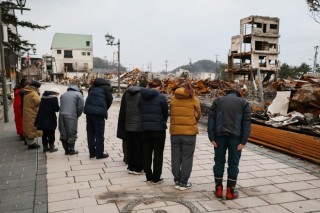Loading
Search
▼ Japan Panel Says 'Megaquake' Probability Up To 82%
- Category:Other
The probability of a "megaquake" in Japan in the next 30 years has marginally increased, a government panel said Thursday, with a 75-82 percent chance of it happening.
Such a jolt could potentially have a devastating 8 to 9 magnitude, trigger colossal tsunamis, kill several hundred thousand people and cause billions of dollars in damage, experts say.
The Earthquake Research Committee said it has increased its estimate of the probability to between 75 and 82 per cent from between 74 and 81 per cent previously.
It concerns what is known as a subduction megathrust quake along the Nankai Trough, an 800km undersea gully running parallel to Japan's Pacific coast.
The trench is where the Philippine Sea oceanic tectonic plate is "subducting" - or slowly slipping - underneath the continental plate that Japan sits on top of.
The plates become stuck as they move, storing up vast amounts of energy that is released when they break free, causing potentially massive earthquakes.
Over the past 1,400 years, megaquakes in the Nankai Trough have occurred every 100 to 200 years, according to the government's Headquarters for Earthquake Research Promotion.
The last recorded one happened in 1946.
"It's been 79 years since the last quake, and the possibility of another quake occurring is rising every year at a pace of by about 1 per cent," an official of the Earthquake Research Committee's secretariat told AFP.
According to government estimates in 2012, smaller islands off the main coasts could be swamped by a tsunami over 30m high.
Densely populated areas on the main islands of Honshu and Shikoku could be hit by huge waves within a few minutes.
Last August the Japan Meteorological Association (JMA) issued its first megaquake advisory under rules drawn up after the devastating Tohoku earthquake and tsunami of 2011.
It said that the likelihood of a new major earthquake along the Nankai Trough was higher than normal after a magnitude 7.1 jolt that injured 15 people.
The advisory was lifted again after a week but caused shortages of rice and other staples as people restocked their emergency stores.
In 1707, all segments of the Nankai Trough ruptured at once, unleashing an earthquake that remains the nation's second-most powerful on record.
That quake - which also triggered the last eruption of Mount Fuji - was followed by two powerful Nankai megathrusts in 1854, and then two in 1944 and 1946.
Such a jolt could potentially have a devastating 8 to 9 magnitude, trigger colossal tsunamis, kill several hundred thousand people and cause billions of dollars in damage, experts say.
The Earthquake Research Committee said it has increased its estimate of the probability to between 75 and 82 per cent from between 74 and 81 per cent previously.
It concerns what is known as a subduction megathrust quake along the Nankai Trough, an 800km undersea gully running parallel to Japan's Pacific coast.
The trench is where the Philippine Sea oceanic tectonic plate is "subducting" - or slowly slipping - underneath the continental plate that Japan sits on top of.
The plates become stuck as they move, storing up vast amounts of energy that is released when they break free, causing potentially massive earthquakes.
Over the past 1,400 years, megaquakes in the Nankai Trough have occurred every 100 to 200 years, according to the government's Headquarters for Earthquake Research Promotion.
The last recorded one happened in 1946.
"It's been 79 years since the last quake, and the possibility of another quake occurring is rising every year at a pace of by about 1 per cent," an official of the Earthquake Research Committee's secretariat told AFP.
According to government estimates in 2012, smaller islands off the main coasts could be swamped by a tsunami over 30m high.
Densely populated areas on the main islands of Honshu and Shikoku could be hit by huge waves within a few minutes.
Last August the Japan Meteorological Association (JMA) issued its first megaquake advisory under rules drawn up after the devastating Tohoku earthquake and tsunami of 2011.
It said that the likelihood of a new major earthquake along the Nankai Trough was higher than normal after a magnitude 7.1 jolt that injured 15 people.
The advisory was lifted again after a week but caused shortages of rice and other staples as people restocked their emergency stores.
In 1707, all segments of the Nankai Trough ruptured at once, unleashing an earthquake that remains the nation's second-most powerful on record.
That quake - which also triggered the last eruption of Mount Fuji - was followed by two powerful Nankai megathrusts in 1854, and then two in 1944 and 1946.
- January 16, 2025
- Comment (0)
- Trackback(0)


